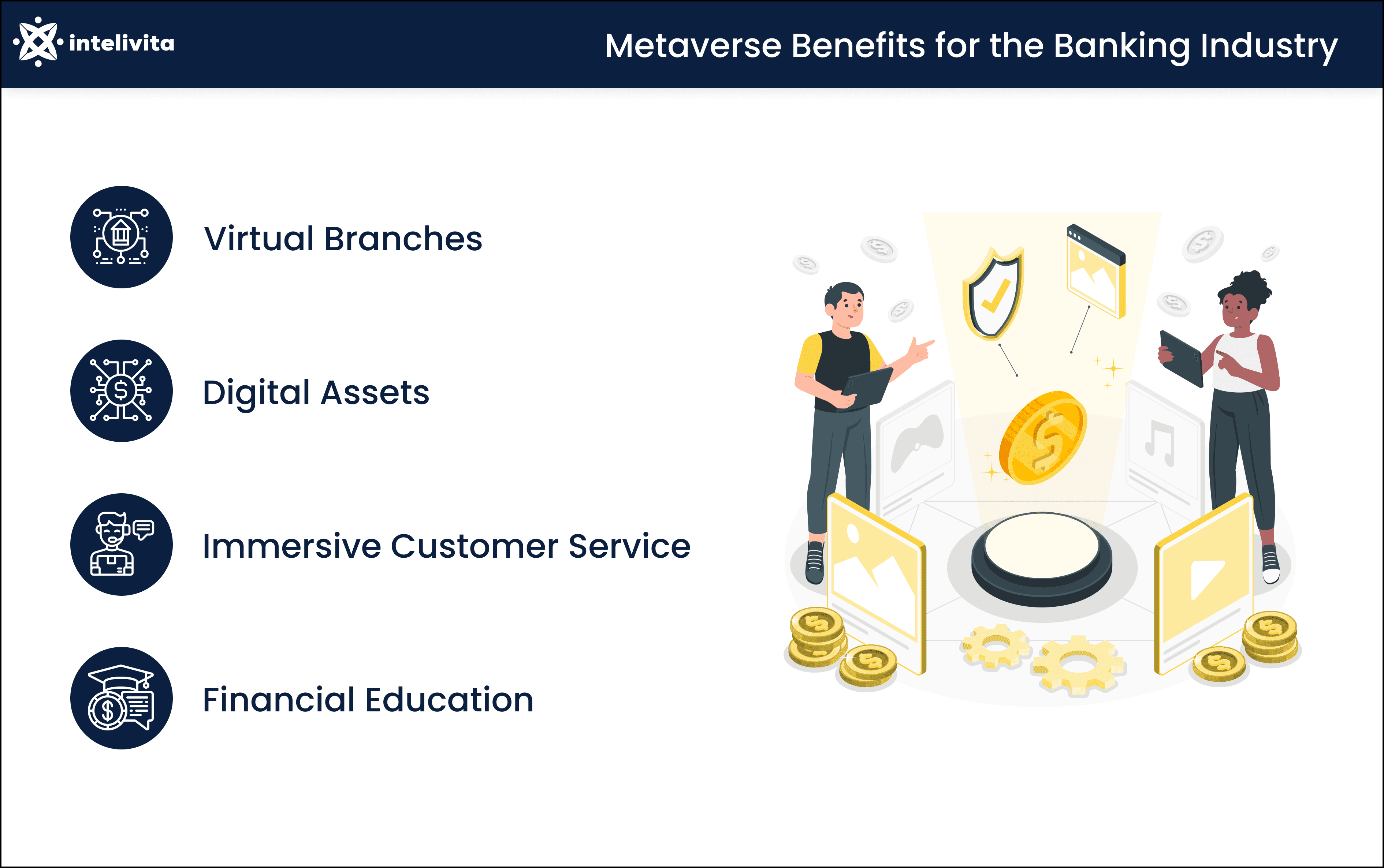Are you ready to step into a digital universe where the possibilities are limitless?
The metaverse isn’t just about gaming; it’s poised to transform banking as we know it.
Discover how banks are leveraging the metaverse for enhanced customer service and digital transactions.
Read on to unlock the metaverse’s potential in banking and contact our metaverse experts to navigate this transformative landscape effectively.
Now, let’s delve into the metaverse’s statistics to get a sense of its scale and potential.
What Exactly is Metaverse?
The Metaverse, a term coined from “meta-” (meaning beyond or transcending) and “universe,” represents a collective virtual shared space where users can interact, transact, and engage with digital environments through avatars.
It’s not just a single platform but a network of interconnected virtual worlds, offering endless possibilities.
Discover limitless possibilities with Intelivita’s Metaverse development services.
Sign up for a free consultation with us to transform your project into a digital masterpiece.
Metaverse Benefits for the Banking Industry
The Metaverse promises numerous advantages for banks.
It offers a novel way to engage customers, educate them about financial matters, facilitate digital transactions, and even expand into decentralized finance (DeFi).
To leverage these benefits fully, banks must navigate the Metaverse landscape effectively.
-
Virtual Branches
Banks are creating virtual branches within the metaverse, allowing customers to conduct banking transactions, attend financial education seminars, and even meet with virtual financial advisors.
-
Metaverse Banking with Digital Wallets
Banks are leveraging digital wallets to bridge the gap between blockchain technology and decentralized applications in the metaverse.
This enables users to seamlessly manage their digital assets, facilitating the receipt, storage, and transfer of tokens within the metaverse.
-
Immersive Customer Service
Chatbots and virtual assistants in the metaverse provide customers with immediate support, answering queries and resolving issues in real-time.
-
Digital Assets
With the rise of blockchain technology, banks are embracing the concept of digital assets within the metaverse.
Customers can securely store, trade, and manage cryptocurrencies and other digital assets through metaverse banking platforms.
-
Financial Education
Virtual classrooms and interactive experiences in the metaverse enable banks to offer financial literacy programs, helping customers make informed financial decisions.
Statistics of the Metaverse
The metaverse isn’t just a whimsical concept; it’s a burgeoning reality with impressive statistics:
- The metaverse market is projected to reach a staggering $800 billion by 2024. It’s not just a niche; it’s a thriving industry.
- According to a study by Metaversed, the metaverse will reach 400 million daily active users (DAUs) in 2022.
- According to Bloomberg, the global Metaverse revenue opportunity could approach $800 billion in 2024, up from around $500 billion in 2020.
Now that we’ve established the metaverse’s significance let’s explore how it’s impacting the banking sector.
Metaverse’s Key Components and Technologies
At its core, the Metaverse is powered by technologies like virtual reality (VR), augmented reality (AR), blockchain, and artificial intelligence (AI).
VR and AR create immersive environments, blockchain ensures secure transactions, and AI enables intelligent avatars and interactions.
Metaverse Platforms for Banking
Metaverse platforms designed for banking are the virtual spaces where these financial innovations come to life.
These platforms offer secure, immersive, and user-friendly environments for customers to access banking services and engage with financial institutions.
Key Metaverse Platforms in the Banking and Finance Sector
Decentraland for Banking: Decentraland, a blockchain-based virtual world, offers decentralized finance (DeFi) solutions, enabling users to participate in lending, borrowing, and trading of digital assets while maintaining control of their funds.
Metaverse Banking Apps: Specialized metaverse banking applications are being developed, allowing users to access their traditional bank accounts and digital assets seamlessly within virtual environments. Sandbox’s metaverse banking is at the forefront of this digital revolution, and the collaboration with KEB Hana Bank promises to bring even more convenience to users.
Virtual Reality Banking: VR platforms provide a fully immersive banking experience, enabling customers to visit virtual branches, attend meetings, and access financial services using VR headsets.
Crypto Wallets in the Metaverse: Metaverse platforms integrated with cryptocurrency wallets allow users to manage and transact with digital assets effortlessly.
Metaverse Ecosystem in Banking
The metaverse ecosystem in banking encompasses the various stakeholders, technologies, and services that collaborate to deliver innovative financial solutions within the metaverse.
Components of the metaverse ecosystem in banking include:
Banks and Financial Institutions: Traditional banks are exploring metaverse opportunities to adapt to evolving customer preferences and offer cutting-edge financial services.
Blockchain Technology: Blockchain platforms underpin the security and transparency of digital assets and transactions within the metaverse banking ecosystem.
Fintech Startups: Startups are pioneering metaverse-focused fintech solutions, pushing the boundaries of what’s possible in virtual finance.
Virtual Financial Advisors: AI-powered virtual financial advisors guide users through investment strategies and financial planning, enhancing financial literacy within the metaverse.
Regulatory Bodies: Regulatory bodies are actively monitoring and shaping the regulatory framework for metaverse banking, ensuring compliance and consumer protection.
Investors and Capital: Investors are injecting capital into metaverse banking startups, recognizing the immense potential of virtual finance.
Use Cases of Metaverse in the Banking Industry
The banking industry is undergoing a significant transformation, thanks to the integration of the metaverse.
The way metaverse is reshaping the financial sector by introducing innovative use cases that enhance customer experiences, streamline operations, and drive financial inclusion.
1. Virtual Banking Branches
Metaverse technology enables banks to establish virtual branches where customers can interact with banking services, staff, and advisors in immersive virtual environments.
These virtual branches offer services ranging from account management and loan applications to financial consultations, all within the metaverse.
This use case extends accessibility to financial services for customers worldwide, eliminating geographical limitations.
2. Digital Asset Management
With the rise of blockchain technology, banks are using the metaverse to offer digital asset management services.
Customers can securely store and manage their cryptocurrencies and other digital assets within their e-wallets.
The metaverse provides a transparent and secure environment for users to track, trade, and invest in digital assets, creating opportunities for diversified portfolios.
3. Virtual Financial Education
Financial literacy is crucial, and the metaverse is a powerful tool for educating customers.
Banks can host virtual financial literacy seminars, workshops, and interactive educational experiences within the metaverse.
Users can learn about budgeting, investing, and financial planning in an engaging and immersive manner, fostering better financial decision-making.
4. Interactive Customer Support
The metaverse introduces innovative customer support solutions.
Virtual chatbots and AI-driven virtual assistants provide immediate and personalized assistance to users, addressing their banking queries and concerns in real-time.
This 24/7 support enhances customer satisfaction and reduces response times.
5. Virtual Reality Banking
Virtual reality (VR) technology allows customers to experience banking services in an entirely immersive way.
Users can access their bank accounts, attend meetings with advisors, and visualize financial data in a virtual environment.
VR banking transcends the limitations of physical branches, making banking more engaging and accessible.
6. Blockchain-Based Transactions
The metaverse integrates blockchain technology to facilitate secure and transparent transactions.
Banks can leverage blockchain for cross-border payments, reducing transaction costs and increasing transaction speeds.
Smart contracts within the metaverse automate processes like loan approvals and insurance claims, enhancing efficiency.
7. Virtual Financial Consultations
Metaverse platforms enable customers to have one-on-one consultations with financial advisors in virtual spaces.
These consultations offer personalized financial guidance and investment strategies.
Users can share financial documents, review portfolios, and make informed decisions in a secure virtual environment.
8. Financial Inclusion
The metaverse has the potential to bridge the financial inclusion gap by reaching underserved populations.
Virtual banking services can extend to remote and unbanked regions, providing access to banking, payments, and financial education to previously excluded individuals.
9. Secure Authentication
Metaverse banking prioritizes security through advanced authentication methods.
Biometric authentication within virtual environments ensures secure access to financial services, protecting customer accounts and data.
10. Gaming and NFT Integration
Banks can leverage the metaverse’s gaming culture and NFT (Non-Fungible Token) technology to engage customers.
Virtual rewards, in-game currencies, and unique digital assets can be integrated into banking experiences, creating gamified financial interactions.
Data Privacy and Security Challenges of Metaverse in FinTech
Identity and Authentication Risks
In the metaverse, user identities are often represented by avatars or digital personas. Verifying the identity of users and ensuring that they are authorized to access financial services can be challenging.
Fraudulent activities and identity theft could potentially thrive in such an environment.
FinTech companies operating in the metaverse must develop robust identity verification and authentication mechanisms to protect user accounts and financial transactions.
Virtual Asset Security
The metaverse introduces a new dimension to asset ownership with the concept of digital assets, including cryptocurrencies, NFTs, and virtual property. Securing these assets against theft or unauthorized access is paramount.
The decentralized nature of some metaverse technologies, like blockchain, can enhance security, but it also necessitates a high degree of user responsibility.
FinTech platforms must educate users about secure storage practices and implement safeguards like multi-signature wallets and cold storage solutions.
Privacy in Virtual Transactions
Financial transactions conducted within the metaverse are not immune to prying eyes. Maintaining transaction privacy is a challenge, as blockchain-based transactions are often transparent and traceable.
Achieving financial confidentiality while adhering to regulatory requirements remains a delicate balance that FinTech firms must navigate.
Privacy-focused blockchain solutions and zero-knowledge proofs can help protect transactional privacy in the metaverse.
Data Ownership and Control
In the metaverse, user data can be stored across various platforms and decentralized networks.
This distributed data landscape raises concerns about who owns and controls the data. FinTech companies must clearly define data ownership rights and implement robust data access controls.
Users should have the ability to manage and revoke data permissions, even within virtual environments.
Compliance and Regulation
The metaverse operates across international boundaries, making it challenging to establish uniform regulatory standards.
Different jurisdictions may have varying data privacy and financial regulations.
FinTech companies must navigate this regulatory landscape, ensuring compliance with anti-money laundering (AML), know-your-customer (KYC), and data protection regulations.
This can be particularly complex in a metaverse where physical locations and jurisdictions blur.
Cybersecurity Threats
As the metaverse expands, it becomes a prime target for cyberattacks.
Hackers may exploit vulnerabilities in virtual environments, targeting both users and financial institutions.
Denial-of-service attacks, phishing attempts, and malware infections can disrupt financial services and compromise user data.
FinTech firms must invest in robust cybersecurity measures, conduct regular audits, and educate users about online security best practices.
Data Interoperability Challenges
The metaverse is a fragmented landscape with various platforms and technologies.
Ensuring data interoperability and secure data exchange between different metaverse environments is a significant challenge.
FinTech companies need to develop standardized data protocols and encryption methods to enable secure data sharing across platforms while maintaining user privacy.
Ethical Considerations
In a virtual environment, where user experiences are highly immersive, collecting and utilizing data for behavioral analysis and personalization raises ethical questions.
Striking a balance between offering tailored financial services and respecting user privacy and consent is a challenge that requires careful ethical considerations and transparency.
Regulatory and Legal Considerations for Metaverse in Finance Industry
-
Jurisdictional Complexity
One of the primary challenges in the metaverse is determining which jurisdiction’s laws and regulations apply.
Virtual worlds exist beyond physical borders, making it difficult to pinpoint where transactions occur and where legal responsibilities lie.
Financial entities operating in the metaverse must carefully consider the international scope of their activities and work to ensure compliance with multiple jurisdictions’ laws.
-
Know Your Customer (KYC) and Anti-Money Laundering (AML) Compliance
Regulators require financial institutions to perform KYC and AML checks on their customers to prevent money laundering and the financing of illicit activities.
In the metaverse, maintaining KYC and AML compliance can be challenging, as user identities may be pseudonymous or anonymous.
Financial entities must develop innovative methods for identifying and verifying metaverse users while adhering to regulatory requirements.
-
Data Privacy and Ownership
The metaverse presents unique data privacy challenges.
User data is often scattered across various virtual platforms and decentralized networks, raising questions about data ownership and control.
Financial institutions must clearly define data ownership rights, implement stringent data access controls, and ensure compliance with data protection regulations like the General Data Protection Regulation (GDPR) and the California Consumer Privacy Act (CCPA).
-
Smart Contracts and Legal Enforcement
Smart contracts, which automate and self-execute financial transactions, are a fundamental component of the metaverse.
However, disputes arising from smart contracts may require legal resolution.
The legal enforceability of smart contracts and the recognition of virtual agreements in traditional legal systems remain areas of uncertainty that need to be clarified by regulators and courts.
-
Intellectual Property Rights
The metaverse is a creative space where users can create and trade digital assets, including virtual real estate, art, and digital fashion.
Protecting intellectual property rights in this digital environment is crucial.
Financial entities must navigate the complex landscape of copyright, trademark, and patent laws within the metaverse to prevent infringement and protect their own assets.
-
Securities Regulation
Tokenized assets, initial coin offerings (ICOs), and non-fungible tokens (NFTs) in the metaverse can blur the lines between traditional securities and virtual assets.
Regulators are closely examining these virtual financial instruments to determine whether they should be subject to securities regulations.
Financial entities must stay vigilant to evolving regulatory frameworks and ensure compliance with relevant securities laws.
-
Taxation and Reporting
Metaverse transactions, especially those involving virtual currencies and assets, raise tax considerations.
Determining the tax implications of metaverse activities can be complex, as they may vary based on jurisdiction and the nature of the transaction.
Financial institutions must work closely with tax authorities to ensure accurate reporting and compliance with tax laws.
-
Consumer Protection
Protecting consumers in the metaverse is a paramount concern.
Financial entities must provide clear terms and conditions, transparent pricing, and mechanisms for dispute resolution within virtual financial services.
Ensuring that users are not subject to predatory practices or scams is crucial for maintaining trust and reputation.
Metaverse Challenges and Obstacles in Banking
Security Concerns
Security is a paramount concern in the metaverse. Banks must ensure that customer data, transactions, and digital assets are secure within virtual environments.
The decentralized nature of blockchain technology, while offering security benefits, also introduces new vulnerabilities.
Protecting against cyberattacks, fraud, and unauthorized access is a top priority for banks operating in the metaverse.
Regulatory Complexity
Navigating the regulatory landscape in the metaverse is challenging.
As a decentralized and global space, the metaverse operates beyond traditional jurisdictional boundaries.
Banks must grapple with varying international regulations, including data privacy, financial compliance, and consumer protection laws.
Adhering to these regulations while providing seamless services in virtual environments is a complex task.
Identity Verification
Verifying user identities in the metaverse can be problematic.
Avatars and pseudonymous profiles make it challenging to conduct robust know-your-customer (KYC) checks and anti-money laundering (AML) screenings.
Banks must develop innovative solutions for identity verification while ensuring compliance with regulatory requirements.
Privacy and Data Protection
The metaverse raises significant privacy and data protection concerns.
Banks must define clear data ownership and control mechanisms within virtual environments.
They must also address the challenge of transparent data sharing and consent management while adhering to evolving data protection regulations like GDPR and CCPA.
User Education
Many users may be new to the metaverse, and understanding the complexities of virtual finance can be daunting. Banks must invest in user education to ensure that customers have the knowledge and skills to navigate and secure their virtual financial assets.
Educating users about the risks and best practices is essential for a safe metaverse banking experience.
Interoperability
The metaverse is a fragmented space with various platforms and technologies.
Ensuring interoperability and seamless data exchange between different metaverse environments can be a significant challenge.
Banks must work toward standardized data protocols and interoperable solutions to provide a consistent user experience.
Smart Contract Legalities
While smart contracts offer automation and efficiency in the metaverse, their legal enforceability remains uncertain in many jurisdictions.
Banks must navigate the complexities of contract law and ensure that smart contracts align with legal requirements.
Dispute resolution mechanisms for virtual agreements need to be established.
Risk Management
Virtual assets and currencies in the metaverse can be highly volatile.
Banks must implement robust risk management strategies to protect both their own investments and customer assets.
Monitoring and managing risk within virtual financial markets is a novel and complex task.
Technological Infrastructure
Creating and maintaining the necessary technological infrastructure for metaverse banking is resource-intensive.
Banks must invest in the development of secure, scalable, and user-friendly metaverse platforms.
This includes integrating blockchain technology, virtual reality interfaces, and advanced cybersecurity measures.
Ethical Considerations
The immersive nature of the metaverse raises ethical questions related to user behavior and financial interactions.
Banks must address ethical concerns, such as addiction to virtual finance, behavioral analytics, and ensuring fair and transparent financial services within virtual environments.
Metaverse Future Trends and Opportunities for Banking
-
Virtual Banking Hubs
The metaverse is paving the way for the creation of virtual banking hubs, where customers can access a wide range of financial services in immersive digital environments.
These hubs can replicate the traditional brick-and-mortar bank experience, complete with virtual tellers, financial advisors, and interactive digital interfaces.
Customers will be able to open accounts, apply for loans, and manage their finances in a highly personalized and engaging manner within the metaverse.
-
Enhanced Customer Engagement
The metaverse offers banks an unprecedented opportunity to engage with customers on a whole new level.
Banks can create virtual spaces for financial education, product demonstrations, and customer support.
Customers can attend financial literacy workshops, explore interactive financial simulations, and even attend virtual financial events and conferences.
These immersive experiences will deepen customer relationships and drive brand loyalty.
-
Digital Asset Integration
The integration of digital assets within the metaverse is a significant trend.
Banks will have the opportunity to offer secure storage, trading, and management of cryptocurrencies and other digital assets.
Users can seamlessly transition between traditional and digital banking services within the metaverse, creating a unified financial ecosystem that caters to diverse asset types.
-
Cross-Border Payments and Remittances
The metaverse has the potential to simplify cross-border payments and remittances.
Blockchain technology and digital currencies can streamline international transactions, reducing fees and settlement times.
Banks can leverage the metaverse to provide customers with faster and more cost-effective cross-border financial solutions.
-
Virtual Reality Banking
Virtual reality (VR) technology will play a prominent role in the future of banking.
Users can access their bank accounts, attend virtual meetings with financial advisors, and visualize their financial data in immersive VR environments.
This level of engagement will make banking more intuitive and user-friendly.
-
Decentralized Finance (DeFi) Integration
The metaverse and DeFi are natural allies.
DeFi applications can be seamlessly integrated into metaverse platforms, allowing users to access lending, borrowing, and yield farming services while navigating virtual worlds.
Banks can collaborate with DeFi projects to provide secure and regulated DeFi options within the metaverse.
-
Personalized Financial Services
Data analytics and artificial intelligence (AI) will enable banks to offer highly personalized financial services within the metaverse.
AI-driven virtual financial advisors will provide tailored recommendations, investment strategies, and budgeting advice.
Users will experience a level of personalization that was previously unimaginable.
-
Gaming and NFT Banking
The metaverse’s gaming culture and the rise of non-fungible tokens (NFTs) present unique opportunities.
Banks can create virtual branches within popular online games, offering in-game financial services, rewards, and virtual asset management. Users can trade NFTs representing virtual real estate or digital art within the metaverse, creating new revenue streams for banks.
-
Financial Inclusion
The metaverse can help bridge the financial inclusion gap by reaching underserved populations.
Virtual banking services can extend to remote and unbanked regions, providing access to basic financial services, payments, and digital assets.
This has the potential to empower individuals and communities worldwide.
-
Collaboration and Partnerships
Collaboration will be key to harnessing the metaverse’s potential.
Banks may form strategic partnerships with technology companies, blockchain startups, and virtual world developers to create innovative metaverse banking solutions.
These collaborations will drive innovation and the development of metaverse financial ecosystems.
Discover Metaverse Banking and Get Started Today!
The metaverse is not just a fanciful concept but a dynamic and growing reality with immense potential.
Its impact on the banking industry is already palpable, from virtual branches and improved customer service to innovative financial education and cross-platform transactions.
However, navigating this transformative landscape requires careful consideration of data privacy, legal issues, and technical challenges.
As the metaverse continues to evolve, it presents a world of opportunities for the banking industry.
Whether it’s embracing decentralized finance or exploring innovative use cases, banks have a chance to be at the forefront of this technological revolution.
So, if you’re intrigued by the metaverse’s potential in banking and want to explore it further, don’t hesitate to contact our metaverse experts.
They’ll guide you through this transformative frontier, ensuring your institution remains at the forefront of innovation in the banking industry.
Don’t miss out on the metaverse revolution. Contact us today and seize the limitless possibilities it offers for your bank and its customers.






